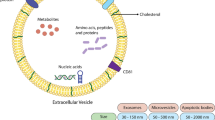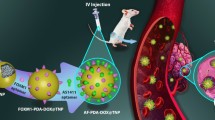Summary
To reduce recurrence in the patients with bladder cancer after tumor removal through open surgery or transurethral resection, a form of gelatin-adriamycin sustained drug release system was developed and its release kinetics bothin vitro andin vivo, its efficacy in inhibiting BIU-87 bladder tumor cell growthin vitro and its safetyin vivo were studied. The results showed that this system controlled adriamycin release over a period of 21 daysin vitro and significantly inhibited BIU-87 cell growth. When this system was injected into rabbit bladder, it sustained adriamycin release for 12 days and the released drug could diffuse 1 cm around the injection point. No major complications were observed except minor acute nonspecific cystitis that could be tolerated well by the animals. This study suggests the possibility of applying this system locally in treating bladder cancer.
Similar content being viewed by others
References
Jakse G. Jung P. Superficial Bladder Cancer. In: Krane R J, Siroly M B, Fitzpatrick J M eds. Clinical Urology. Philadephia: J. B. Lippincott Company, 1994. 645–661
1993, 14 (2):108
Gabizon A, Sulkes N, Ben-Baruch Tet al. Exploratory clinical phase of limpsome-entrapped doxorubicin. J Cell Biochem, 1988, Suppl 12 B: 251
Delgado G, Potkul P K, Treat J Aet al. A phase I / II study of intraperitoneally administered doxorubicin entrapped in cardiolipid limpsomes in patients with ovarian cancer. Am J Obstet Gynecol, 1989, 160(4):812
Kim S, Turker M S, Chi E Yet al. Preparation of multivesicular liposomes. Biochmica et Biphysica Acta, 1983, 728:339
Balazsovits J A E, Mayer L L D, Bally M Bet al. Analysis of the effect of liposome encapuslation on the vesicant proterties, acute and cardiac toxicities, and anti-tumor efficacy of doxorubin. Cancer Chemother Pharmacol, 1989, 23:81
Rahamn A, Carmichael D, Harris Met al. Comparative pharmacokinetics of free doxorubicin and doxorubicin entrapped in cardilipin liposomes. Cancer Research, 1986, 46:2295
Glashan R W. Treatment of carcinoma in situ of the bladder with doxorubicin. Cancer Chemother Pharmacol, 1983, 11 Suppl:35
Matsumura Y. Intravesical adriamycin chemotherapy in bladder cancer. Cancer Chemother Pharmacol, 1983, 11 Suppl:69
Bono A V, Benventi C, Camiano Get al. Results of transurethral resection and intravesical doxorubicin proghylaxis in patients with T1G3 bladder cancer. Urology, 1994, 4(3):329
Gekker H. Controlled release of biologically active compounds from bioeodible polymers. Biomaterials, 1980, 1: 51
Author information
Authors and Affiliations
Rights and permissions
About this article
Cite this article
Zhangqun, Y., Jie, C., Xu, Z. et al. Novel gelatin-adriamycin sustained drug release system for intravesical therapy of bladder cancer. Current Medical Science 21, 145–148 (2001). https://doi.org/10.1007/BF02888081
Received:
Published:
Issue Date:
DOI: https://doi.org/10.1007/BF02888081




